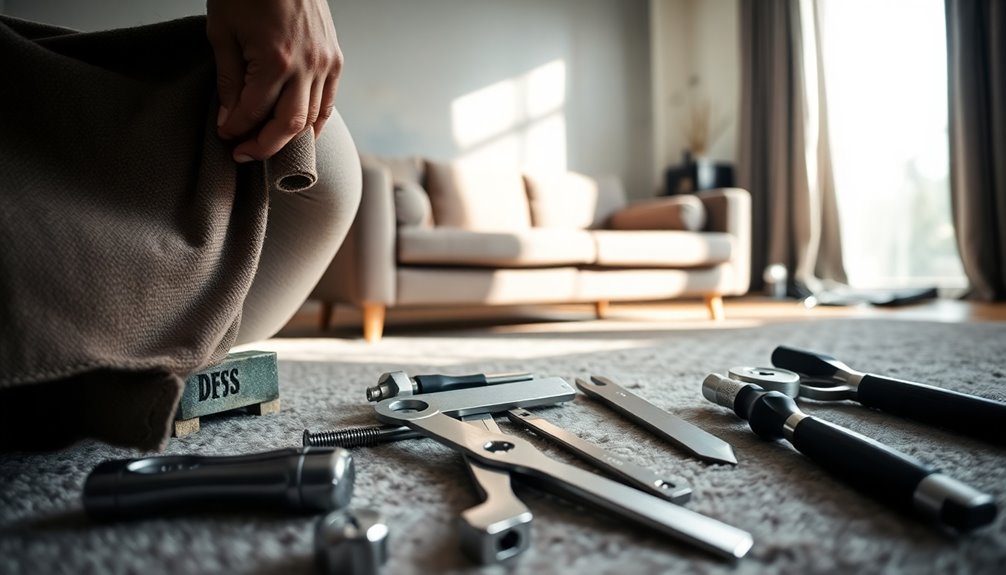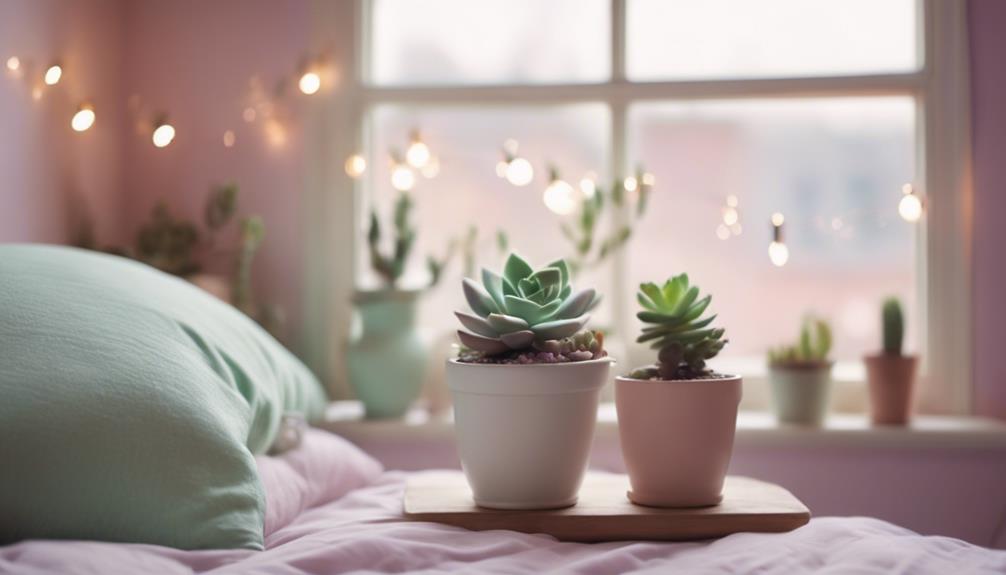To dismantle your DFS sofa, you'll need a screwdriver, wrench, and pliers. Start by clearing the area around the sofa. Begin with the arms, unscrewing them from the base. Next, remove the backrest by unscrewing it, then take off the seat cushions and any removable covers. Make sure to keep all screws and bolts in a labeled container for easy reassembly. If your sofa has a bed mechanism, carefully detach it to avoid damage. For smooth transport, measure your vehicle and secure the dismantled parts with blankets and straps. There's more to learn about maintaining your sofa's condition and easy transport methods.
Key Takeaways
- Gather necessary tools, including a screwdriver, wrench, and pliers, before starting the dismantling process.
- Clear the area around the sofa to ensure easy access and movement while dismantling.
- Begin by removing the arms of the sofa, followed by unscrewing the backrest from the base.
- Detach any cushions and removable covers, keeping all fasteners in a labeled container for easy reassembly.
- Carefully handle the sofa bed mechanism, identifying attachment points and folding it securely to save space during transport.
Introduction
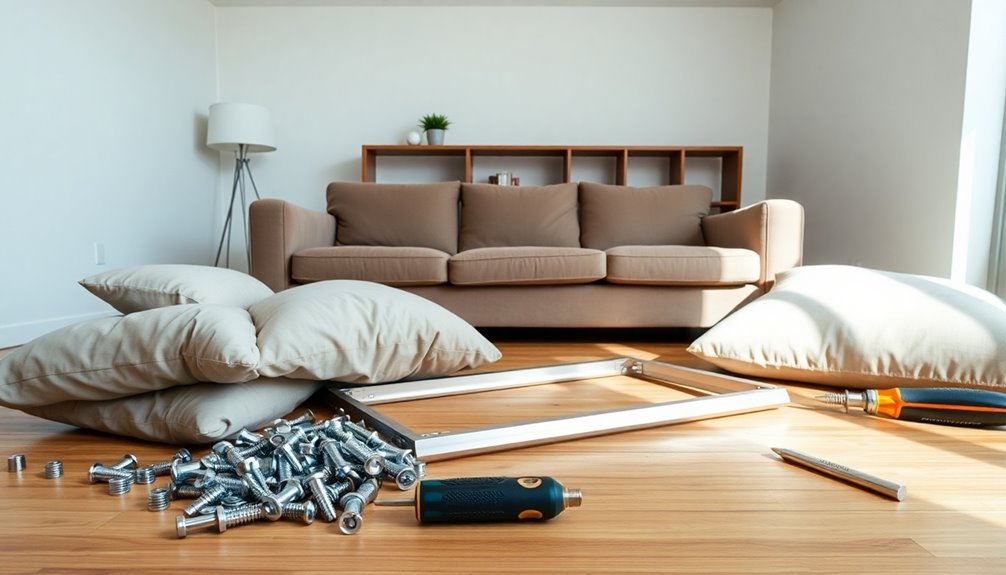
When it comes to maintaining your sofa, routine dusting and vacuuming are key to keeping it fresh. You'll also want to learn fabric-specific cleaning techniques to avoid damage while tackling tough stains, like those pesky wine spills. This guide will help you effectively care for your sofa and ensure it looks great for years to come.
Routine Dusting and Vacuuming
Regular dusting and vacuuming are essential for keeping your DFS sofa looking its best and extending its lifespan. Over time, dirt and allergens accumulate, making routine cleaning crucial. Start with dusting; use a soft, lint-free cloth to gently wipe down the surfaces. This prevents scratches on both fabric and leather, ensuring your sofa maintains its aesthetic appeal.
Next, focus on vacuuming. Use an upholstery attachment to effectively eliminate dust, pet hair, and debris from crevices and cushions. It's recommended to vacuum your sofa at least once a week, especially if you have pets or children, to prevent buildup. Regular vacuuming not only keeps your sofa fresh but also helps in maintaining the integrity of the fabric.
For deeper cleaning, consider using a fabric cleaner or upholstery shampoo every six months. This can help remove stubborn stains and refresh the texture of your sofa. Additionally, be mindful of the air quality in your home, as air purifiers can help reduce allergens that may settle on your furniture. By incorporating these simple but effective cleaning routines, you'll prolong the life of your DFS sofa, making it a more enjoyable and hygienic seating option for your home.
Fabric-Specific Cleaning Techniques
Choosing the right cleaning technique for your sofa fabric is crucial for maintaining its beauty and longevity. Different fabric types, like microfiber, velvet, and linen, require specific cleaning solutions, so the first thing you should do is check the care label for instructions. For water-safe fabrics, a mixture of mild detergent and water can work wonders. Just grab a soft cloth or sponge and gently dab the stained area.
If your upholstery is labeled "dry clean only," you'll want to avoid any DIY solutions. Instead, use solvent-based cleaners or take it to a professional cleaner to prevent damage. Regular vacuuming is also essential; it helps maintain the appearance of your entire sofa by preventing dust buildup and extending its lifespan. Additionally, keeping your home clean and free from allergens can support a healthier lifestyle while enjoying your sofa.
For tough stains, a mixture of white vinegar and water can be effective. However, it's always best to test this on a small, inconspicuous area first to ensure colorfastness. By following these fabric-specific cleaning techniques, you've got a better chance of keeping your sofa looking fresh and inviting for years to come.
Eliminating Wine Stains Effectively
Even with the best cleaning techniques, accidents happen, and wine stains can be particularly challenging. When that glass of red spills on your sofa, act quickly to minimize damage. Start by blotting the stain immediately with a clean cloth to absorb the excess liquid. Avoid rubbing, as that can spread the stain further.
Next, mix a solution of one part white vinegar, one part dish soap, and two parts water. This mixture effectively breaks down the wine's pigments. Apply the solution to the stain using another clean cloth, letting it sit for about 30 minutes. Afterward, blot the area again with a damp cloth to lift the stain.
If you're dealing with stubborn stains, sprinkle baking soda over the area after applying the vinegar solution. This can help lift the stain when scrubbed gently. Once you've treated the area, rinse it with cold water and allow it to air dry. Before using any heat, like a hairdryer, check to ensure the stain is completely gone. With these steps, you can tackle wine stains effectively and keep your sofa looking its best.
Moisture and Sunlight Protection
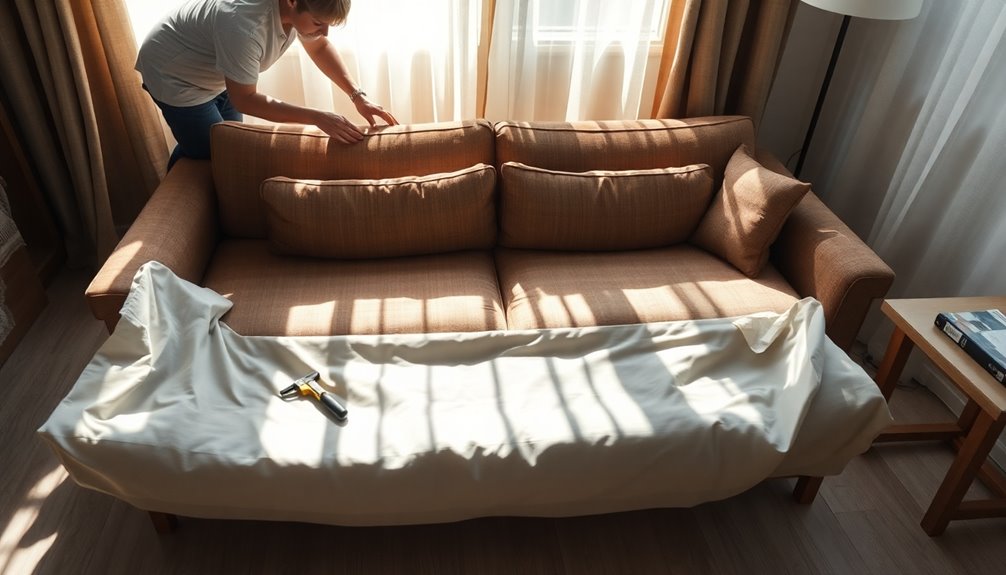
To keep your sofa looking great, you'll want to choose scratch-resistant fabric that can withstand everyday wear. Stylish fabric protection options can also guard against moisture and stains while maintaining your sofa's aesthetic appeal. Don't forget to reinforce high-traffic areas to ensure your sofa stays in top shape for years to come.
Scratch-Resistant Fabric Selection
When it comes to selecting scratch-resistant fabric for your DFS sofa, prioritizing materials that offer moisture and sunlight protection is crucial. Look for microfibers or tightly woven synthetic fibers, as they provide superior durability against wear and tear. These fabrics are designed to resist scratches while also standing up to daily use.
To protect your sofa from spills, choose fabrics treated with water-repellent coatings. This ensures that moisture doesn't penetrate the upholstery, preventing damage or unsightly stains. Additionally, consider UV-resistant fabrics, especially if your sofa will be exposed to direct sunlight. These materials help prevent fading and deterioration, making them perfect for bright, sunny rooms.
A blend of polyester and acrylic can be an excellent choice, as it offers a balance of softness, scratch resistance, and longevity. However, always check the manufacturer's care instructions. Some scratch-resistant fabrics may require specific cleaning methods to maintain their protective qualities. By selecting the right fabric, you'll keep your DFS sofa looking great and extending its lifespan, ensuring it remains a comfortable centerpiece in your home.
Stylish Fabric Protection Options
Choosing stylish fabric protection options for your sofa can significantly enhance its longevity while maintaining a chic look. Moisture-resistant treatments are a fantastic choice, as they repel spills and stains, keeping your sofa's fabric looking fresh and clean. By opting for these protective solutions, you're not just safeguarding your investment; you're also ensuring your space remains stylish.
In addition to moisture protection, consider UV-resistant sprays or coatings to shield your sofa from sunlight. These solutions help prevent fading and deterioration from prolonged exposure, allowing you to enjoy your beautifully upholstered sofa for years to come. With many fabric protection products available in various finishes, you can easily find options that complement your sofa's aesthetic.
If you have children or pets, you'll appreciate that some treatments are eco-friendly and non-toxic, providing effective moisture and sunlight protection without harmful chemicals. Regularly applying these protective treatments can extend the lifespan of your sofa's fabric, saving you from costly repairs or replacements down the line. By being proactive about fabric protection, you can keep your sofa looking stylish and new while enjoying peace of mind. Additionally, taking preventative measures like regular inspections can help ensure your furniture remains in excellent condition over time.
Reinforcing High-Traffic Areas
Protecting high-traffic areas of your sofa from moisture and sunlight is essential for maintaining its appearance and durability. Start by applying water-repellent fabric treatments. These treatments can help withstand spills and prevent absorption, keeping your sofa looking fresh. Next, invest in UV-resistant fabric protectors to shield your upholstery from sunlight, which can cause fading and deterioration over time.
Don't forget to regularly rotate your cushions and pillows. This simple action distributes wear evenly, reinforcing high-traffic zones and extending the lifespan of your upholstery. Additionally, using area rugs in front of the sofa can absorb moisture and dirt, minimizing direct contact with the fabric.
Consider placing your sofa in indirect sunlight or using window treatments like shades or curtains. This can significantly reduce sun exposure, further protecting against potential damage. By taking these proactive steps, you ensure your DFS sofa remains a stylish and functional centerpiece in your home, even in the busiest areas. Remember, a little maintenance goes a long way in preserving the beauty and longevity of your furniture.
Preventive Care Strategies
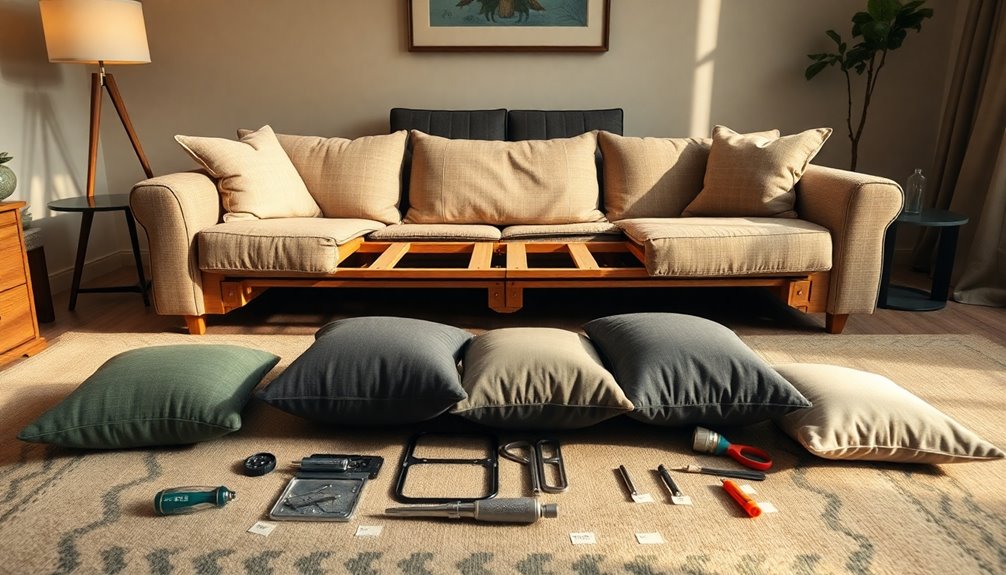
To keep your sofa in top shape, it's crucial to focus on preventive care strategies. Start by regularly checking the frame for any loose screws and ensure the cushions are fluffed to maintain their form. If you have a leather sofa, knowing basic repair techniques can also help you address wear before it becomes a bigger issue. Additionally, using best oils for hair growth can provide essential nutrients that help maintain the overall health of the sofa's materials.
Frame Integrity Concerns
Maintaining the frame integrity of your sofa is crucial for its longevity and comfort. Regularly inspect the frame for signs of wear, such as cracks or loose joints. Catching these issues early can save you from more significant repairs later. Use felt pads or coasters under the legs of the sofa to prevent damage to the floor and reduce stress on the frame when moving it. This simple step can help maintain the frame's stability.
Be mindful of the weight on the sofa bed mechanism. Avoid excessive weight, especially when the bed is in the folded position, to prevent bending or breaking. It's also essential to periodically check that all screws and bolts are tightened. Loose fittings can compromise the stability of the frame and lead to further damage, so make it a habit to tighten them.
Finally, store your sofa in a climate-controlled environment. Fluctuations in humidity can cause the wooden frame to warp or swell, affecting its integrity. By taking these preventive care strategies seriously, you'll ensure your DFS sofa remains sturdy and comfortable for years to come. Additionally, maintaining the sofa's integrity can be likened to building trust issues in relationships, as both require regular attention and care to prevent deterioration.
Leather Repair Techniques
Leather furniture can elevate the style of any room, but it requires careful attention to keep it looking its best. To maintain the suppleness of your leather, apply a leather conditioner every 3-6 months. This prevents cracking and extends the life of your furniture. When spills happen, act fast—grab a soft, damp cloth to clean them immediately. This quick response helps stop stains from settling into the leather fibers.
Placement matters too. Keep your leather furniture out of direct sunlight and away from heat sources. Prolonged exposure can lead to unsightly fading and drying. Regular maintenance is crucial; use a soft brush or a vacuum with a soft attachment to remove dust and dirt. This helps prevent scratches and wear on the leather finish.
Before using any cleaning or repair products, always test them on a hidden area first. This ensures compatibility and protects your leather from potential damage. Additionally, maintaining good indoor air quality with air purifiers can help prevent dust and allergens from settling on your furniture. By following these preventive care strategies, you'll keep your leather furniture looking stunning for years to come.
Cushion Fluffing Techniques
Keeping your furniture in great shape goes beyond just caring for the leather; it also involves looking after the cushions. Regularly fluff and rotate the cushions every few weeks to maintain their shape and prevent sagging. This simple action can significantly extend their lifespan.
To keep your cushions clean and fresh, use a vacuum with an upholstery attachment to remove dust and debris. This helps prevent compression over time, ensuring they stay comfortable. When your cushions aren't in use, store them in a cool, dry place to avoid moisture buildup, which can lead to mold and mildew.
Investing in removable cushion covers is a smart move, as you can wash them to keep everything looking new. Between deep cleanings, consider using a fabric refresher spray to maintain the appearance and smell of the cushions. This can help keep your living space inviting.
Personalized Cushion Designs

Personalized cushion designs can truly transform the look of your sofa, giving it a unique flair that reflects your style. By incorporating unique patterns, colors, and textures, you can create a visually appealing space that feels distinctly yours. Custom cushions can be tailored to fit your sofa perfectly, ensuring not just a cohesive look but also improved comfort.
You have the option to print custom images or designs on your cushions, allowing you to showcase personal artwork or cherished family photos. This adds an emotional touch that store-bought cushions simply can't match. When choosing fabric, consider your lifestyle; options like cotton, linen, or velvet provide varying levels of durability and comfort.
Additionally, personalized cushions can be practical. Many designs feature removable covers, making them easy to clean and maintain. This means you can keep your sofa looking fresh without the hassle of extensive upkeep. So whether you're looking to make a statement or simply enhance your living space, personalized cushion designs are an excellent way to express your individuality while ensuring your sofa remains a cozy and inviting place to relax.
Maintenance for Aging Sofas
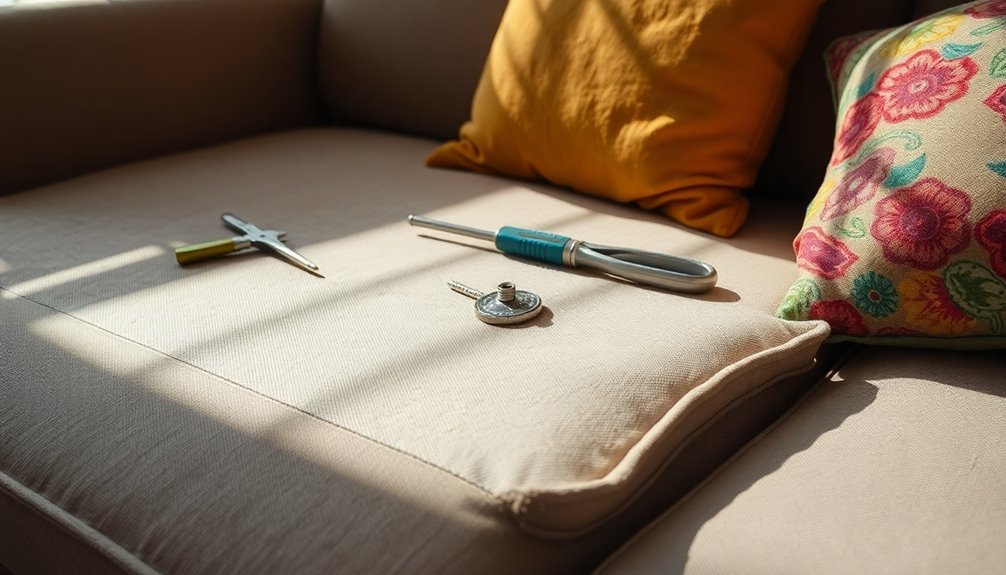
Aging sofas can still be the centerpiece of your living space with the right maintenance. Start by regularly inspecting the frame and joints for any signs of wear or damage. Catching these issues early can prevent further deterioration and keep your sofa lasting longer.
Next, don't forget to clean and condition the upholstery, whether it's leather or fabric. Doing this periodically helps maintain its appearance and prevents cracking or fading over time. You should also check and tighten screws and bolts in the sofa's structure to maintain stability, which can help eliminate annoying squeaks or wobbles.
To keep your cushions in top shape, rotate and fluff them regularly. This simple step prevents uneven wear and extends their life. Finally, consider using sofa covers or throws. They protect against stains and damage from pets or spills, which can significantly extend your sofa's lifespan. Additionally, using natural products for cleaning can help ensure that the materials remain safe and healthy for your home environment.
Conclusion
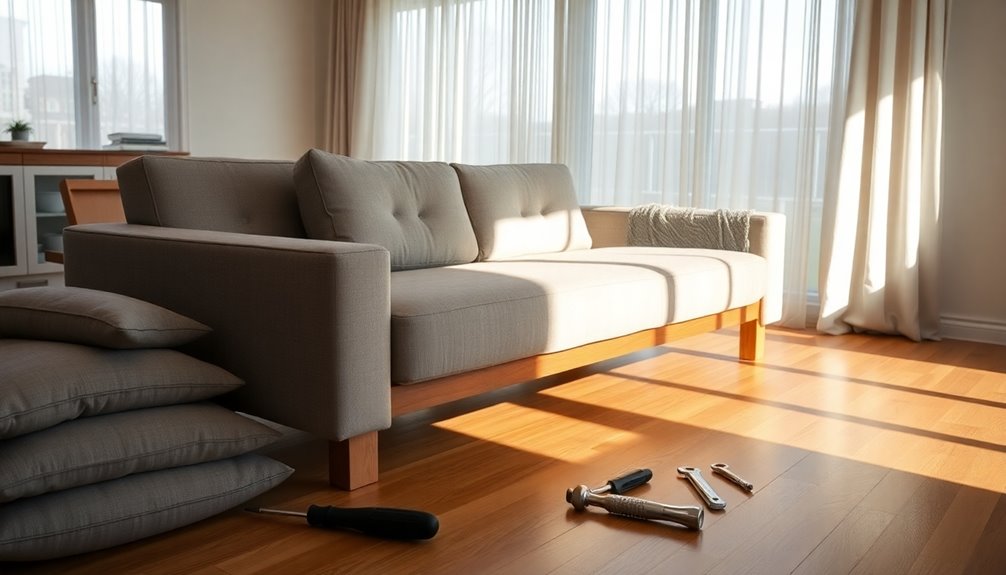
Maintaining your sofa is just the beginning; knowing how to dismantle it properly can also enhance its longevity and facilitate any necessary repairs or moves. By following the right steps, you can ensure that your DFS sofa is safely taken apart, making it easier to transport or store.
Start by laying the sofa on its front and removing the cushions to access the mechanism and armrests effortlessly. Use a 13mm socket to unfasten the bolts on both sides of the sofa bed mechanism, and don't forget your crosshead screwdriver for the screws. This methodical approach helps you keep track of all the parts. Remember, each armrest is secured with three bolts, so make sure you detach all six bolts for smooth removal.
When it's time to transport your dismantled sofa, securely tie down the sofa bed mechanism and fold it to save space. Ensuring all parts fit snugly in your vehicle is crucial for safe transport. Lastly, consider recycling your sofa at a local center after dismantling. This contributes to responsible waste management and sustainability, making your efforts more meaningful.
Frequently Asked Questions
Can You Take a DFS Sofa Apart?
Yes, you can take a DFS sofa apart. It typically involves removing its mechanisms and armrests to make transport easier. Grab a 13mm socket and a crosshead screwdriver to access and remove bolts and screws. Most parts are detachable, so you'll just need to turn the bolts anti-clockwise. Lay the sofa on its front for better access, and it's a good idea to have a friend help you for stability.
Do DFS Sofas Come Apart for Delivery?
Yes, DFS sofas do come apart for delivery. They're designed to be easily disassembled, making it simpler for you to maneuver through tight spaces like doorways and staircases. You can typically remove components like cushions and armrests without much hassle. It's a good idea to have a friend help you out during the process, ensuring everything stays stable and safe while you transport your sofa to its new location.
Can You Dismantle a Sofa to Fit Through a Door?
Yes, you can dismantle a sofa to fit through a door. Most sofas have detachable parts like armrests and cushions that you can easily remove. Grab a 13mm socket to take off the arms, and use an electric screwdriver for the bed mechanism. Make sure you've got enough space to work and a helper to lift heavy pieces. Once you've disassembled it, transport the parts securely in your vehicle to avoid any damage.
How Do I Take My Sofa Apart for Moving?
To take your sofa apart for moving, start by removing all cushions and any detachable parts. Lay the sofa on its front for better access. Use the right tools, like a socket and screwdriver, to unscrew the bolts holding the mechanism and armrests in place. Once you've detached everything, carefully fold or tie the pieces for transport. Make sure all parts fit securely in your vehicle to ensure a safe move.
